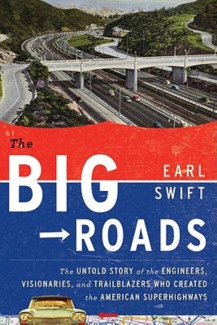Just in case you thought that suburbanization of the 20th century was a joint venture between God, the invisible hand, and a pot of gold delivered by the Freedom Fairy, Earl Swift's Big Roads might make you think again.
As it turns out, the interstates and other superhighways that gave life to the suburbs were not preordained. They did not design themselves, and they certainly did not build themselves. Swift gives voice to all those lanes of concrete that we take for granted now but were, in their day, one of the most audacious feats of engineering and public finance in human history.
The story of America's highways starts later than that of America's automobiles, and therein lay the challenge for early road-builders. Not long after the turn of the century, auto companies had hit upon the basic formula for the car, and combustible promoters like Carl Fisher -- a former bicycles salesman turned founder of the Indianapolis 500 -- told Americans to buy them. But for every early auto, there were dozens of stories of getting stuck in the mud, spooking horses, or worse. One particularly harrowing off-road journey was attempted by a certain Army lieutenant named Dwight D. Eisenhower, who participated in the first ever cross-country convoy in 1919. Cannonball Run, it was not.
If there's anyone who doesn't like Ike, it's Earl Swift. Though the Interstate Highway System bears Eisenhower's name and is generally credited to him, Swift's account gives credit to the forgotten engineers who envisioned a national road system while Ike was scarcely out of Basic Training. Upon taking office, Eisenhower called for a national highway system and yet, according to Swift, "didn't kow that the executive and legislative branches had already worked out the details of the network he sought." Though his sources are unclear, Swift accounts for this oversight by reporting that "the thirty-fourth president wasn't much of a reader" and hated long briefings. And thus the Interstate Highway System sprung unsullied from the general's imagination.
The real heroes of big roads, if highway-building can be considered heroic, are Thomas MacDonald and his successor Frank Turner, the engineers who led the federal effort at the helm of the Bureau of Public Roads. MacDonald shephered the national highway system from 1919 to 1953--not only fighting for funding and plotting routes but also inventing the system of highway numbering that remains to this day--with Turner taking over thereafter. Both dull and exacting, nearly to the point of parody (MacDonald responded only to the name "Chief," and then with as few words as possible), neither makes a great protagonist for a national epic. These were men who, according to Swift, "assumed...that everything Americans loved or hated about their cities was quantifiable." For better or worse, their work speaks for itself.
In the absence of human drama, Swift delves deep into the policies and funding schemes that first led to the system of U.S. "routes"--the first among them being the scattershot Lincoln Highway--and eventually to the cohesive interstate system that was described in the FDR-era manual Toll Roads and Free Roads and ultimately codified in the 1956 Federal-Aid Highway Act. Swift covers both the national-scale questions of how many transcontinental highways would be built and how much money Washington would contribute, to the local questions and, particularly, those dark instances in which urban highways did as much to segregate cities nationwide as Jim Crow laws ever did. All told, the government committed 750,000 eminent domain takings in the construction of the interstates.
Swift himself takes a neutral position on the aesthetic value of mega-highways, though he does pay significant attention to the well known (and often racially freighted) battles over urban highways in the 1960s. But his main point is, that for better or worse, those roads didn't get there by accident. And, as a result, neither did the houses, families, and suburban angst that followed them.

The Big Roads: The Untold Story of the Engineers, Visionaries, and Trailblazers Who Created the American Superhighways
Earl Swift
Houghton Mifflin Harcourt

